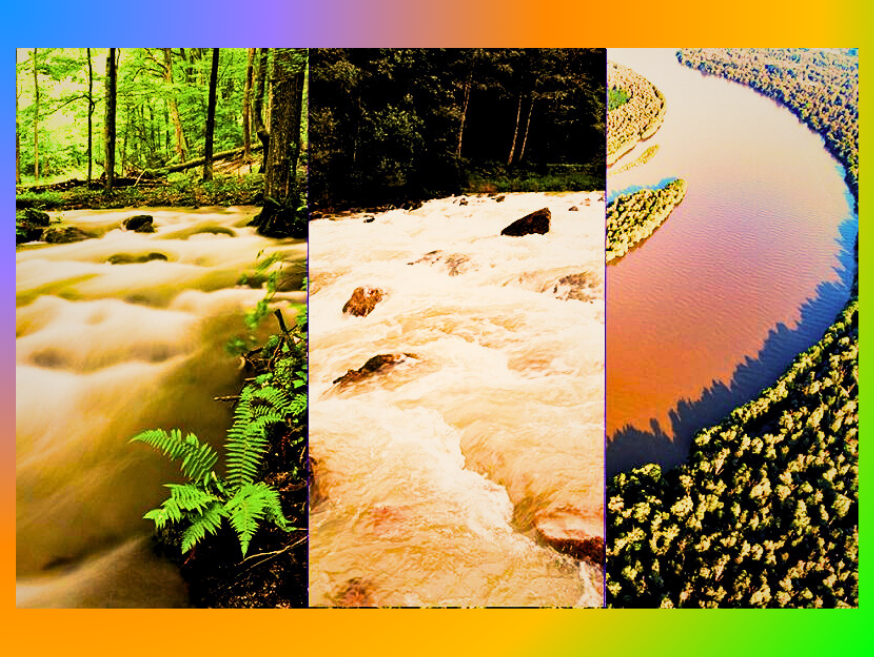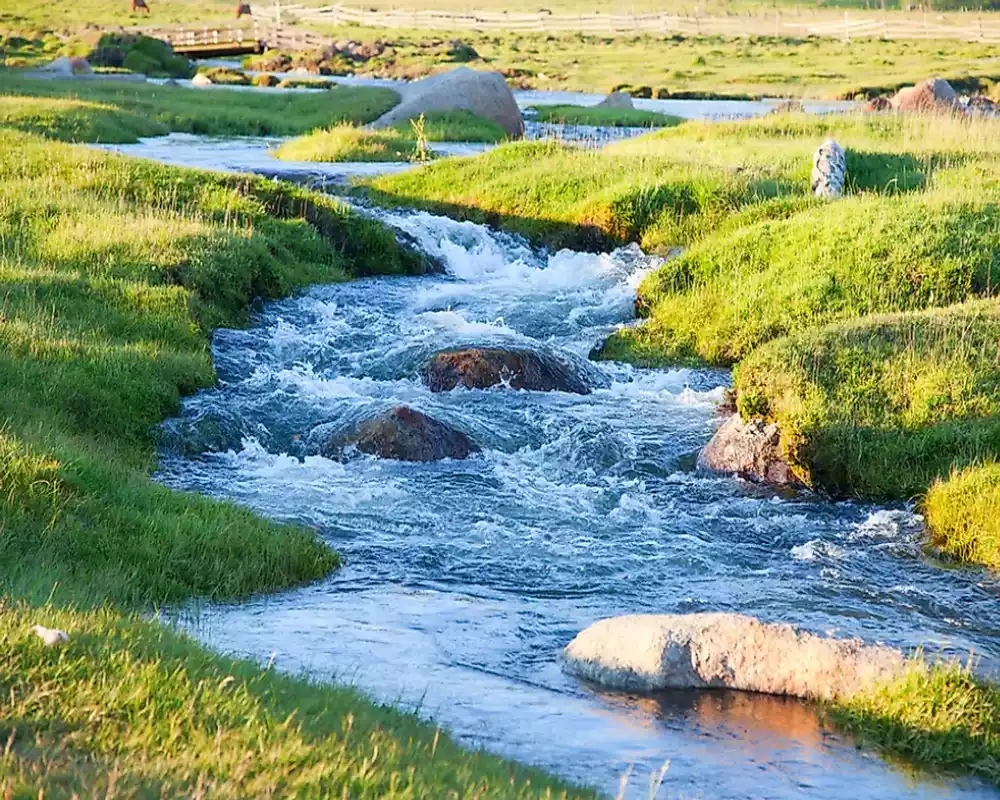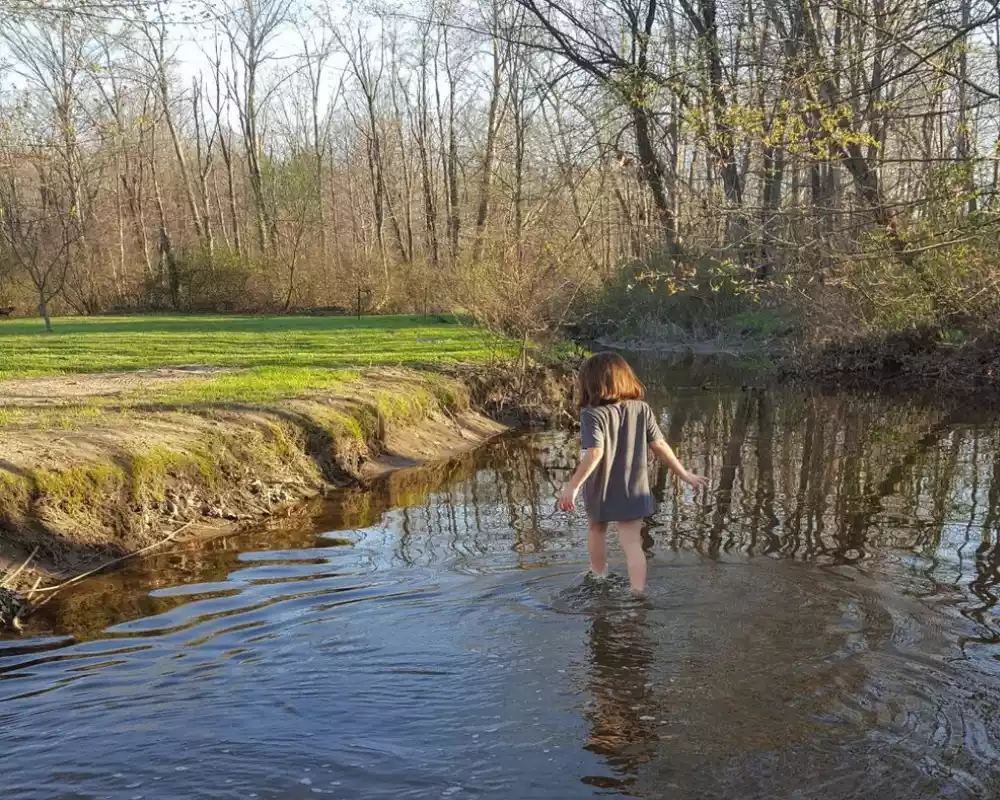History of Stream and Creek
Creeks and streams have existed on Earth ever since its water system first took form millions of years ago, coursing across its surface and forming landscapes while simultaneously opening new watercourses.
Here is a short history of creeks and streams:
- Geological Processes: Creeks are formed through geological processes like tectonics, weathering, and erosion that shape Earth’s crust over millions of years to create valleys and depressions in its landscape.
- Ancient Rivers: Many of the streams and creeks we see today are descendants of ancient rivers that once flowed here, though their paths may have altered over time due to geological forces, climate shifts, or continental shifts.
- Glacial Activity: During glacial periods, vast ice sheets covered large parts of Earth. Glaciers carved valleys as they advanced and retreated. Meltwater from melting glaciers also created streams and creeks which flowed down new channels created by them, complicating drainage patterns and creating streams and creeks that eventually vanished over time.
- Human Settlements: Water has always played an essential part in human settlement near rivers and streams. Ancient civilizations understood its vitality for irrigation, farming, and drinking purposes – cities were even established along rivers or waterways!
- Industrialization: The Industrial Revolution was responsible for drastic alterations and modifications of streams and creeks across the world, altering both use and the environment in significant ways. Human activities including dam building, channelization and pollution from agricultural and industrial sources have both positively and negatively impacted these watercourses. Meanwhile, global urbanization increased pressure on freshwater bodies which altered natural flows as well as ecosystems within them.
- Conservation and Restoration: Conserving and restoring streams and creeks have become ever more vital to environmental health and function. Conservation efforts focus on maintaining water quality while creating natural habitats while mitigating human impact as much as possible.

Earth’s geologic, human and environmental histories are inextricably tied together. Creeks and streams have played an essential part in shaping landscapes and supporting ecosystems while providing essential resources to human society. Understanding their history gives us greater appreciation of their significance while aiding efforts to preserve vital watercourses.
Importance of understanding the difference Stream and Creek
Understanding the difference between streams and creeks is important for several reasons:
- Communication Is Key: Communicating clearly when discussing watercourses is of vital importance. Understanding the difference between streams and rivers allows scientists, environmental professionals and members of the public to exchange accurate and precise information regarding them without creating unnecessary confusion or delays in transmission of important news about them.
- Studies on Ecologies: Creeks and streams offer diverse ecosystems, each one possessing specific environmental conditions and habitats that researchers can utilize when studying ecosystems in this way. Understanding differences between creeks and streams allows ecologists and researchers to classify ecosystems more accurately as this facilitates conservation strategies as well as identification of species inhabiting these watercourses.
- Water Resource Management: Creeks and streams provide us with access to freshwater for many activities and needs, making an understanding of their differences paramount for water resource planning and management. Assessing availability, meeting quality criteria requirements and creating strategies to conserve, protect, preserve and use sustainably are among their numerous applications.
- Land Use Planning: It is of key importance when planning land use and development to distinguish between streams and creeks in order to make informed decisions regarding setbacks, conservation measures and protection strategies for each watercourse, thus assuring appropriate land-use implementation that preserves their integrity as well as supporting associated ecologies.
- Environmental Impact Assessments: When conducting Environmental Impact Assessments of human activity on water resources, distinguishing between streams and creeks is vitally important. Doing this enables accurate evaluation of potential ecological, hydrological or water quality impacts associated with land-use change projects or pollution sources that impact hydrology or ecology directly or indirectly. It allows more precise evaluation of ecological, hydrological or water quality impacts associated with such developments or changes or pollution sources.
- Frameworks for Policy and Regulation: Governments, regulatory agencies and other organizations often create policies, guidelines or regulations related to water resources management and protection. By understanding differences among streams and rivers, policies or guidelines may be tailored specifically for their characteristics allowing effective regulation, permitting processes or monitoring programs to be created more easily.
Understanding the differences between streams and creeks is vitally important for effective communication, ecological studies, water resource planning and management, land use decisions, environmental assessments and policy making. Knowing their distinction enables informed decisions while helping ensure conservation and protection of these vital natural ecosystems.
What is a Stream?

A stream is a body of flowing water typically smaller than rivers that transports its flow by gravity downhill to larger bodies such as lakes or oceans. They play an essential part in hydrology by transporting water from higher elevations down to lower ones through rivers, lakes or oceans before returning back up again via larger bodies like oceans or rivers.
Streams may form from various sources, including springs, runoff from rain or snowmelt runoff, groundwater discharge or erosion. They often form through erosion, accumulation of water in low-lying areas or convergence with smaller tributaries; their channels usually feature meanders, bends or straight sections while their shape and structure may change over time as erosion takes its course and deposition occurs.
Streams receive water from various sources, including precipitation, surface runoff and groundwater sources. While their flow patterns remain fairly consistent depending on factors like seasonal variations, topography or the characteristics of their sources; their flow can change due to seasonal variation, topography or the characteristics of their water sources. They serve an integral part of ecosystem health by offering habitat for aquatic organisms while cycling nutrients back through and maintaining overall quality for ecosystem health.
Characteristics of Streams
Size and Flow Rate:
- Size can range from narrow, small streams to wider, larger rivers.
- Their flow rates can be affected by factors like land slope and rainfall as well as input from upstream sources.
- Streams can provide consistent water flows with consistent volumes and speeds of flow, creating an environment in which living organisms thrive.
Channel Morphology:
- Waterways often feature bends, straight sections or meanders
- As their channels take shape over time from erosion and deposition processes, altering its form over time.
- Environmental conditions and geological characteristics also have an effect on these channels.
Sources of Water:
- Water can enter streams from many sources. These sources include precipitation (rain or snowfall), surface runoff and groundwater discharge; in some regions melting glaciers or ice caps also act as sources.
- These sources of water affect both volume and flow in streams.
Flow Patterns:
- Streams may experience different flow patterns depending on factors like seasonal variation, topography and characteristics of their water source.
- They can range from smooth and slow-flowing to fast and turbulent depending on these and external influences.
- Streams may feature either an ongoing flow (which provides constant water all year) or intermittent flows, in which water stops for various lengths of time before returning again.
Ecological Significance:
- Streams provide habitat to numerous animal and plant lifeforms.
- These habitats provide homes for aquatic organisms like fish, amphibians and invertebrates.
- Streams play an invaluable role in cycling nutrients through watersheds and providing connectivity between organisms in an ecosystem.
- Their presence ensures clean waters for drinking purposes while supporting ecosystem health.
Understanding the characteristics and importance of streams are fundamental for studying water systems, managing resources and assessing their environmental significance. They play a significant role in hydrologic cycling while impacting multiple aspects of environmental sustainability by offering ecosystem services and creating jobs in various forms.
What is a Creek?

A creek is usually defined as a narrow and small stream that flows as part of an larger body like a lake or river, feeding into it from valleys, wooded areas or rural regions. Creek channels tend to be narrower and smaller than their river or stream counterparts.
Creeks form similarly to streams runoff from rainfall, groundwater discharge and the convergence of smaller tributaries are all contributing factors in their formation. They may form by springs, or accumulate water from low lying areas in low lying places. They’re typically found in rural or wooded regions and sometimes form part of an interconnected network of watercourses.
Creeks tend to have narrower and deeper channels compared to streams, often featuring bends, meanders, or small pools on a small scale. Erosion, sedimentation and topography in an area play a role in shaping its shape and structure as well.
Water sources that contribute to creeks include precipitation (snow and rain), surface runoff and groundwater; depending on local hydrological conditions, their relative contributions can differ; flow patterns of creeks tend to be more fluctuant than streams due to weather changes and seasonal shifts affecting them more dramatically than streams do.
Creeks provide habitats and water sources to many plants and animals, connecting various ecosystems together while serving as natural storage tanks, holding onto high flows for longer but gradually releasing during dry times.
Characteristics of Creeks
Size and Flow Rate:
- Creeks tend to be smaller in comparison with streams.
- Creeks tend to be narrower and can carry less water.
- Creeks usually experience lower flow rates compared to streams; their output depends more heavily on seasonal changes.
Channel Morphology:
- Creek channels tend to be narrower and deeper than streams.
- Often featuring features like bends, meanders and small pools in their channel morphology.
- Their formation can also be affected by factors like erosion, sediment transport and topography.
Sources of Water:
- Creeks use similar sources as streams to obtain their water needs; precipitation, surface runoff and groundwater all play important roles in providing supply to creeks.
- Their relative contribution can differ based on local hydrological conditions as well as size.
Flow Patterns:
- Creeks may exhibit various flow patterns that depend on factors like weather conditions and seasonal variations as well as characteristics of their water source.
- Higher flows could occur during periods with heavy precipitation while lesser rain could decrease it further.
Ecological Significance:
- Creeks play an integral part in aquatic ecosystems.
- These aquatic habitats serve as home for an assortment of fish, amphibians and invertebrates.
- Creeks play an essential role in maintaining watershed ecosystems by recycling nutrients and providing passage for organisms to move through them.
- Creek reservoirs may also play an integral role for local fauna and vegetation.
Understanding the characteristics and functions of creeks are vital in managing water resources responsibly while upholding biodiversity and health. Creeks play an essential part of watershed ecosystems by contributing to an overall network of water, supporting various ecosystem services and functions as they do so.
Ecological Significance
Streams
- Biodiversity: Streams provide habitat to an abundance of aquatic ecosystems that sustain an array of animal and plant species, from amphibians and invertebrates to fish.
- Nutrient Cycles: Streams play an essential role in the cycle of nutrients because they transport organic matter, nutrients and sediments downstream, helping exchanges take place among water column, sediments and the riparian zone.
- Water Quality: Streams play an invaluable role in maintaining water quality by filtering contaminants out, reducing sedimentation levels and improving clarity. They serve as natural filters that remove harmful particles from drinking water supplies.
- Riparian Zones: Streams provide home to an important layer of riparian vegetation which serves an invaluable function of stabilizing stream banks, preventing erosion, providing shade and contributing organic material for aquatic eco systems. This rich habitat serves as shelter and food sources for terrestrial wildlife species as well.
Creeks
- Habitat Diversity: Creeks provide niches tailored specifically for different plant and animal species. Their environments support aquatic organisms that have evolved specifically for that creek environment.
- Water Storage: Creeks serve as natural reservoirs of water, holding onto it during times of high flow but gradually releasing it during dry spells, helping ensure base flows continue and that enough is available downstream for downstream needs.
- Hydrological Connectivity: Creeks serve to interconnect a watershed by transporting nutrients, water, organisms and organisms through it, thus increasing hydrological connectivity while supporting ecological interactions among its many parts.
- Erosion control: Natural features associated with creeks can assist with erosion control by stabilizing soil and limiting runoff of sediment – helping preserve both water quality and maintaining landscape integrity.
Creeks and streams play an essential role in ecosystem health and function. As vital habitats that support nutrient cycles, biodiversity, water quality regulation and quality improvement efforts – it is of vital importance that their ecological integrity remains preserved to preserve these freshwater ecologies for years to come.
Human Uses and Impacts
Streams
- Water Supply: Streams provide essential freshwater source that are used for agriculture, livestock watering and industrial processes.
- Water Recreation: Streams offer opportunities for recreation such as fishing, boating and swimming that attract outdoor enthusiasts and nature lovers.
- Hydropower Generation: Rivers that flow sufficiently can be harnessed as renewable sources of power generation.
- Water Management: Streams can be managed to control flooding, store or divert excess water flow; dams and reservoirs may be built along streams in order to regulate their waterflow for consistent delivery of fresh drinking water supplies.
Human activities can have negative impacts on streams:
- Water Pollution: Industrial discharges and agricultural runoff may introduce pollutants such as chemicals, sediment and nutrients into streams that harm aquatic life and diminish water quality. This degrades aquatic habitat.
- Habitat Destruction: Altered stream channels such as channelization, straightening or dredging may diminish biodiversity and disrupt natural habitats, leading to reduced biodiversity and disrupted environments.
- Flow Regulation: Dams or water diversions can alter natural flow patterns, altering downstream flows and potentially impacting their ecological health and integrity.
- Invasive species: Non-native plant species can drastically change stream ecosystems by outcompeting local species and altering its balance, altering balance of ecosystems.
Creeks
- Irrigation: Creeks can provide irrigation of both crops and livestock.
- Watering Holes: Creeks may also serve as watering holes to give livestock access to an ongoing source of fresh drinking water.
- Wildlife Habitat: Creeks provide shelter to an assortment of animal populations that make hunting or wildlife viewing possible in this habitat.
- Land Development: Creeks can play an influential role when making decisions regarding land use, development, setbacks or conservation measures.
Human impacts on creeks include:
- Sedimentation: Land clearing, construction and agricultural practices that cause erosion can increase sedimentation rates significantly and negatively affect both water quality and aquatic habitats.
- Pollution: Runoff from urban areas, agricultural fields, industrial sites and other sources may introduce contaminants such as pathogens, chemicals and nutrients into creeks that pose risks to aquatic life. This threatens aquatic species.
- Habitat Fragmentation: Infrastructure development and urbanization have the ability to fragment creek habitats, diminishing biodiversity while restricting movement of aquatic species. This decreases biodiversity while restricting movement of these aquatic organisms.
- Changed Hydrology: Water used for human needs such as irrigation or domestic purposes can alter creek flows, negatively affecting aquatic environments as well as availability downstream. This impacts aquatic ecologies as well as availability.
Maintaining the necessary equilibrium between human activities and needs and sustainable water resource preservation requires taking measures such as adopting conservation measures and engaging in responsible land-use decisions, while working toward prevention of water pollution to minimize negative effects and ensure long-term viability and health for streams and creeks.
Differences Between Stream and Creek
The differences between streams and creeks can be summarized as follows:
- Size: Streams tend to be larger than creeks; their width can range anywhere from several meters up to hundreds. Creeks tend to be narrower and shallower.
- Flow Rate: Creeks tend to have greater flow rates than streams; streams can provide continuous, unvarying current while creeks’ fluctuation depends on hydrologic conditions and season.
- Channel Characteristics: Streams possess distinct channel characteristics, including meanders and bends in their course; pools and riffles often make an appearance here too! Creeks tend to feature narrower channels with straighter paths.
- Contribution to Drainage: Network Streams can play an essential part in drainage networks; some streams serve as major tributaries to larger rivers while creeks act as smaller feeders before ultimately discharging into rivers or streams.
- Ecological Significance: Both streams and creeks provide important wildlife habitat, yet their biodiversity and diversity of species differ considerably depending on size, flow rate and habitat type. Larger rivers may support more aquatic life.
- Perception and Terminology: The distinction between creeks and streams can vary according to region; some use terms like “stream” or “creek”, while other may provide guidelines or definitions which differentiate based on size or other aspects.
Regional or local definitions or guidelines can have an effect on how we understand differences and characteristics between streams and creeks, making their discussion essential in any discussion involving either of them.
Similarities of Stream and Creek
While streams and creeks have some distinct differences, they also share several similarities, including:
- Water Flow: Creeks and streams are natural watercourses which transport water from higher altitudes to lower ones, driven by gravity to their destinations. Both exhibit an upward flow of water.
- Origin: Both streams and creeks can be formed by similar factors, including springs, runoff from rain or snowmelt and groundwater discharge, erosion and the convergence of smaller tributaries.
- Drainage: Creeks and streams play an essential part in draining a watershed by collecting and diverting rain into larger bodies such as rivers or lakes for storage or distribution.
- Habitats: Streams and brooks provide aquatic species with essential habitat. Home to diverse ecosystems, these watercourses play a critical role in maintaining environmental biodiversity while serving aquatic plants, invertebrates and amphibians alike.
- Environmental Functions: Streams and creeks play vital environmental functions, from controlling waterflow within their respective watershed to contributing to the nutrient cycle and acting as filters that enhance water quality.
- Human Uses: Creeks and streams have traditionally played an essential role in human settlements and activities, including agriculture, irrigation and drinking of freshwater as well as recreational uses such as fishing, swimming and boating.
- Vulnerability to Human Impacts: All streams, creeks and rivers can be vulnerable to human influences and disturbances, from industrial practices such as those performed on farms to habitat destruction caused by land development or channelization or alteration to their natural flow pattern through dam construction. Water pollution caused by such practices as industrial farming may pollute rivers as much as industrial agriculture practices contaminate them; as can alteration to their natural flow pattern due to dam building practices or alteration due to damming activities.
Watercourses vary significantly in their sizes, flows and channel characteristics compared to streams and creeks; nonetheless they share many fundamental similarities that allow you to understand their ecological importance, conservation needs and sustainable management practices for long-term sustainability. Understanding their similarities will enable you to do just this.
Summary
Streams and Creeks are not just water flowing through the land; they are the lifeblood of ecosystems, a sanctuary for wildlife, and a source of solace for humanity. As we celebrate the wonders of these natural watercourses, let us also pledge to protect and preserve them for future generations to enjoy.



